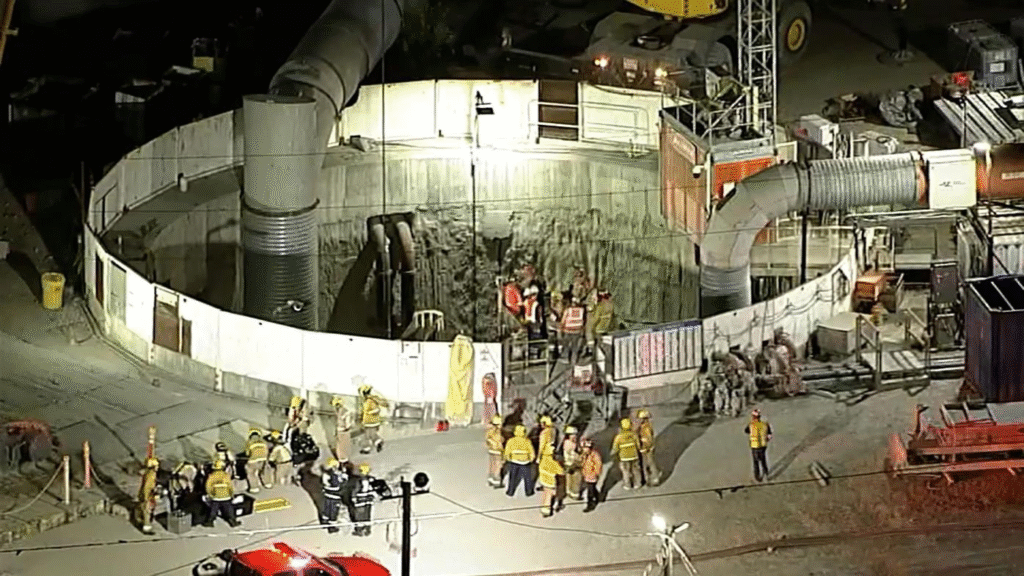Dozens Survive Harrowing Tunnel Collapse 400 Feet Below Ground in Los Angeles
Thirty-one workers were operating deep underground—nearly 400 feet beneath Los Angeles—when disaster struck on Wednesday night. While working inside a narrow, seven-mile tunnel, a portion of the structure suddenly collapsed, trapping the crew more than five miles away from the tunnel’s only entry and exit point.
The tunnel, measuring around 18 feet wide, is a crucial part of the massive Clearwater Project, an ambitious Los Angeles County Sanitation Districts plan aimed at updating the region’s aging wastewater infrastructure. This complex project requires highly trained personnel, including engineers, electricians, and mechanics, to safely handle the heavy machinery and navigate emergencies.
As news of the collapse broke, a tense race against time began.
Workers Scramble for Survival
Trapped far beneath the city, the workers showed extraordinary resolve. Following the collapse, they quickly assessed the situation and began climbing over a mound of loose soil—estimated to be 12 to 15 feet high—that had blocked their path. Their goal was to reach colleagues on the other side and begin a route to safety.
Emergency responders coordinated with tunnel operators to facilitate their extraction. Several workers were hoisted out using cranes and rescue cages, according to footage captured by CNN affiliate KCBS/KCAL.
For Arally Orozco, the collapse was terrifying. She received repeated calls while at church, then a text from her son: the tunnel where three of her brothers worked had collapsed. “We feared the worst.”
Relief came when one of her brothers called. He’d squeezed through a narrow opening in the tunnel to escape and reached the surface.
Rescue Operation and Aftermath
Miraculously, none of the rescued workers suffered visible physical injuries. But the emotional toll was apparent. At a news conference, Los Angeles County Board Supervisor Janice Hahn described meeting the rescued men.
“They were alive and happy, but they were all shaken up,” she said. “It was quite traumatic for them to go through that. The first thing they did was call their family members.”

Hahn also noted that despite the ordeal, there was a sense of relief among the men. “They were light about it, like you would expect when you’re in a very tense situation that could have ended in tragedy—but didn’t. There’s a celebratory sense that people made it out.”
The Collapse and What Went Wrong
The precise cause of the tunnel collapse remains under investigation.
“This type of collapse is highly unusual,” said Robert Ferrante, Chief Engineer and General Manager of the Los Angeles County Sanitation Districts.
Los Angeles Fire Department Captain Danny Wu echoed that sentiment. “I’ve never seen a structural collapse of this magnitude inside a tunnel,” he said. “We’ve had small vehicle accidents or minor fires, but never something this catastrophic.”
Wu added that with only one way in or out, emergency crews had braced for the worst, expecting serious injuries or fatalities. Thankfully, those fears were not realized.
To escape, the men had to walk back through the collapsed section, carefully navigating debris to reach the transport vehicle that would carry them to the access shaft.
Ferrante emphasized how dire the situation had been. “It was very scary,” he said. “We’re incredibly fortunate.”
Training and Preparedness Made the Difference
Officials credited the workers’ expertise and preparedness with preventing a tragedy. Tim McOsker, a city councilman representing the area, praised the crew.
“But they knew what to do. They secured themselves, found the escape vehicle, and followed emergency protocols.”
About the Tunnel and Clearwater Project
The tunnel involved in Wednesday’s collapse is a central component of the Clearwater Project—a major upgrade to Los Angeles County’s wastewater system. The new tunnel is being built to replace two outdated tunnels, which are more than 60 years old and no longer meet modern earthquake safety standards.
According to the county’s website, the old tunnels cannot be taken offline because they are essential to carrying treated wastewater from the Joint Water Pollution Control Plant to the ocean. The new tunnel will allow the system to continue functioning safely for decades to come.
Spanning seven miles, the new tunnel is being constructed almost entirely beneath public streets and is scheduled for completion in 2027. It is designed to serve over five million residents across the Los Angeles Basin.
The project has now been put on indefinite hold while officials conduct structural assessments and review all safety protocols.
Moving Forward with Caution
Michael Chee, spokesperson for the Los Angeles County Sanitation Districts, confirmed that work on the tunnel will not resume until investigations and engineering assessments are complete.
“This project will move forward only when we are confident it can be done safely.”
In the meantime, residents, officials, and loved ones of the workers are simply grateful that the outcome wasn’t worse. What could have been a devastating tragedy turned into a story of resilience, preparation, and survival deep beneath the city of Los Angeles.
